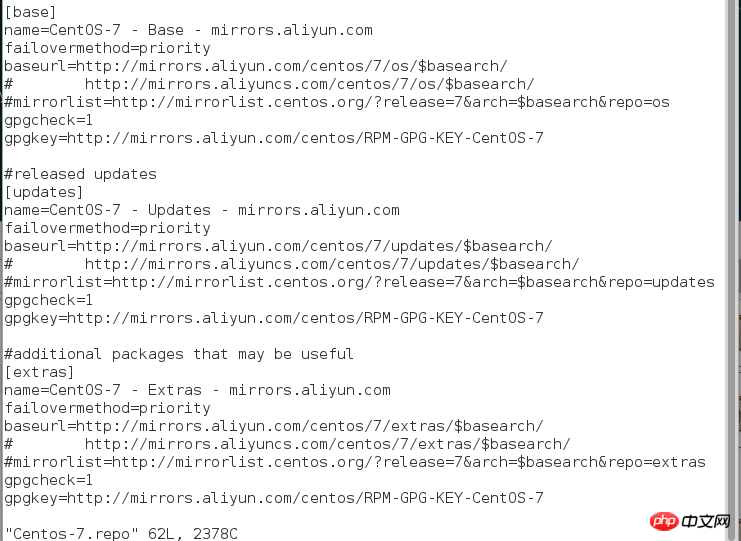
This article introduces how redhat7 uses the domestic Alibaba Cloud yum installation source. The source address used corresponds to the installation source under Centos7.
When I was studying "This is how Linux should be learned" to configure the system environment redhat7, I chose a graphical interface. The yum used did not have any configuration /etc/yum.repos.d/ directory There is no configuration file, so you need to set it manually. Here are some of my steps:
1. Locate the yum configuration file
[root@linuxprobe ~]#cd /etc/yum.repos.d/
2. Check whether there is a configuration file
[root@linuxprobe yum.repos.d]#ls
The blogger’s system has just been installed without any files
3. Check whether yum is installed, what dependencies are installed and delete the yum package
##[root@linuxprobe yum.repos.d]#rpm - qa |grep yum
displays as follows:
yum-utils-1.1.31-24.el7.noarch
yum-langpacks-0.4.2-3.el7.noarch
yum-metadata-parser-1.1.4-10.el7.x86_64
yum -rhn-plugin-2.0.1-4.el7.noarch
PackageKit-yum-0.8.9-11.el7.x86_64
yum-3.4.3 -118.el7.noarch
We need to record the above, and we will need it later when installing a new yum
[root@linuxprobe yum.repos.d]#rpm -qa|grep yum|xargs rpm -e --nodeps Delete yum package
4. After the above steps are completed, we need to update Install yum and change the source address to the source address corresponding to Alibaba Cloud.
Go to the page under the address and use Ctrl+F to search for the file in step 3. Do not bring the version number: such as yum-utils-1.1.31-24.el7. noarch just search for yum-utils.
Such as yum package:
[root@linuxprobe ~]# wget
Others The method of obtaining each package is similar.
After downloading, use rpm -ivh yum-* to install the rpm package. The blogger here prompts an error, as follows:

The above command is caused by the low version of python-urlgrabber we installed, so let’s uninstall python-urlgrabber first.
5. Command to check the python-urlgrabber package
##[root@linuxprobe ~]# rpm -qa|grep python-urlgrabber
6. Execute the following command to delete the python-urlgrabber package##[root@linuxprobe ~]# rpm -qa|grep yum|xargs rpm -e --nodeps
7. Download and install
[ root@linuxprobe ~]# wget
Install python-urlgrabber
[root@linuxprobe ~]#rpm -ivh python-urlgrabber-3.10-8.el7.noarch.rpm
8.python-urlgrabber installation After completion, execute rpm -ivh yum-* to install yum to the computer.

If during the installation process it is prompted that the package resource is a dependency of our installation, then Just install it.
#9. After the package installation is completed, we still need to configure the source address of yum.
1) Locate the folder where the configuration file is located:
[root@linuxprobe~]# cd /etc/yum .repos.d/
2) Check whether there are files in the yum.repos.d folder, and obtain the Alibaba Cloud source configuration file:
[root@linuxprobe yum.repos.d]# ls
[root@linuxprobe yum.repos.d]#wget
For specific help information, please view the Alibaba Cloud help documentation.

10. Modify the value of $releasever
##The configuration file Centos-7.repo we obtained has a $releasever after it is opened. This is a yum variable. We need to replace it, otherwise the source cannot be used. If you do not replace it, you can try the yum command to see what is displayed. .
Use the following command to replace $releasever,
[root@linuxprobe ~]# sed -i 's/$releasever/7/g ' /etc/yum.repos.d/Centos-7.repo
There is a problem with getting the value of this variable $releasever. I checked some information, but it is not the same as the blogger system.
There is a yum.conf file under the /etc/ folder, which is configured with

The variable value obtained after changing to =redhat-release is 7.0-1.el7. This is the version number. I haven’t found where to handle this yet. If anyone knows, please let me know.

11. Finally execute yum makecache to generate the cache.
centos-7.repo file contains some uses that are recommended to be commented out. This address is used in the Alibaba Cloud server intranet. We It's impossible to connect to it from my own computer, so I commented this out.


12. View the currently available warehouse yum repolist all
Two of the above pictures are not enabled. I’ll leave them to Baidu to find out what they are for. If you want to enable them, just change enabled=1 in the Centos-7.repo file. 
The above is the detailed content of How to use the domestic Alibaba Cloud yum installation source for redhat7. For more information, please follow other related articles on the PHP Chinese website!




